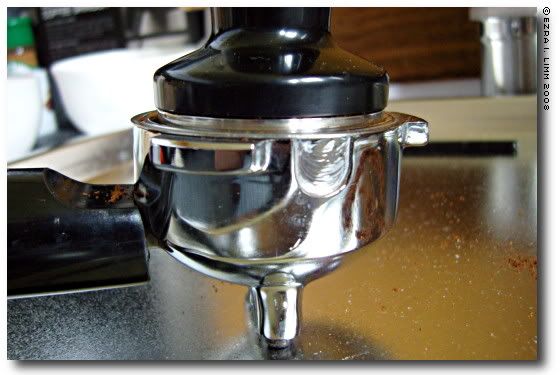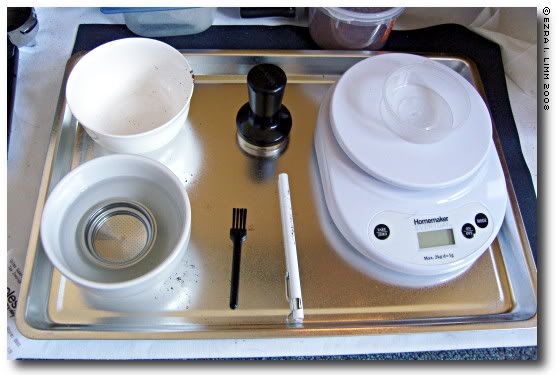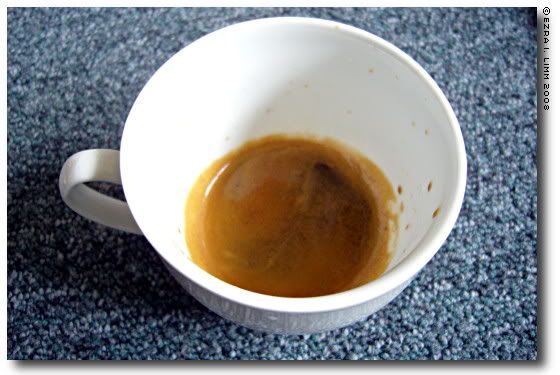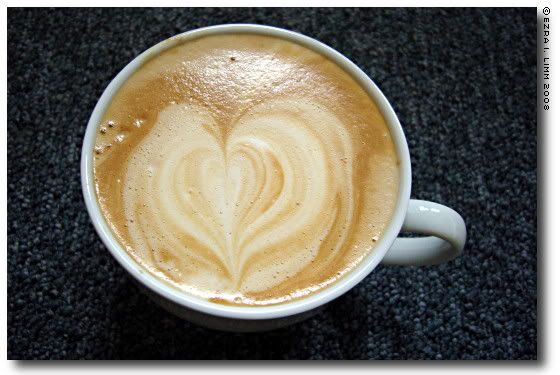Espresso
Nearly a century ago, the Italians discovered a way to extract the most flavour from coffee beans using a balance of temperature and pressure. Fresh ground coffee that is packed tightly into a puck. A small amount of hot water is then forced through the puck to create the emulsion of flavourful oils known as espresso. Coffee beans are 17% oil by weight. This is the reason why instant coffee will always taste bland compared to any kind of coffee made from freshly grounded coffee (drip, percolated, moka, espresso).
Tamping the grounds into a puck
By varying the pressure and grind, the amount of espresso extracted from each puck can be altered. A slow pour creates a darker, more bitter cup. A quick pour has sharper, more acidic notes. Most cafes extract about 45 ml of espresso in about 25 seconds. I prefer to extract 20ml of espresso in about 20s. This is known as a ristretto (restricted) shot. The lower volume produces a richer and darker emulsion while the shorter extraction time reduces the acidity and bitterness (caffeine content) of the espresso.
It took me a good three months to be able to make acceptable espresso. A measured dose (10g) of beans is carefully weighed and grinded into a porcelain bowl. The porcelain bowl allows me to judge humidity. Humidity is my biggest problem in achieving consistent ristretto shots. Ground coffee is like sand. Dry sand is very porous and water just pours through it quickly - resulting in acidic, sour coffee. Coffee grounds in humid atmosphere is compact and has a lot of resistance. I've choked my machine a number of times. 135 pounds of pressure generated by the machine could barely force out 5ml in 30s when the puck is too dense. Hence, by noticing how the grounds stick to the sides of the bowl, i can vary my tamping force appropriately to reduce the density of the puck. I also had to get a bathroom scale to tamp on to ensure that my tamp was consistent. Making espresso is really an art. Below are some of the more important variables involved in making espresso:
- Consistent dose - the amount of coffee in the basket must be the same each time.
- Consistent grind - the coarseness of the coffee must be just right.
- Freshness - Roasted coffee beans are like bananas. They go bad in about a week. Vacuum packed coffee beans in the supermarket are like canned fruit. They are nothing like real freshly roasted coffee. Freshly ground coffee goes bad within an hour as the flavourful oils oxidize and go sour. Hence, a quality burr grinder is absolutely critical for making espresso.
- Consistent tamping - the pressure applied must be consistent and level. Improper tamping causes channels to form during extraction. Water doesnt flow through the puck equally in all areas resulting in a poor quality, acidic, and less flavourful shot.
Cafe Ristretto
How rich can you make a cup of coffee? Above is a restricted shot (cafe ristretto) made in a 200ml cappuccino cup. 10g of coffee was tamped with about 20kg of force into a dense puck. About 20ml of water, heated to 92 deg C, was forced through the puck in 25 seconds, producing a flavourful emulsion.
Cappuccino
About 150ml of steamed full cream milk was added to the espresso to make a cappuccino. The flavourful oils in the brown coloured crema mixes with the rich full cream milk foam to form the cap from which the drink derives its name. The half inch thick cap of foamed milk helps keep in heat on a cold morning. A latte would also have a similar amount of milk, but the milk would be less foamed, far more dense and more velvety.
espresso + steamed/foamed full cream milk = a proper cappuccino
A proper latte is served in cups no larger than 180ml instead as it does not need so much space to accommodate the foam. I ordered a cafe latte at McDonald's the other day and got a shock when the 400ml(?) cup arrived! The sins of commercial coffee...Hmm, i think i have an idea for my next post on coffee.




